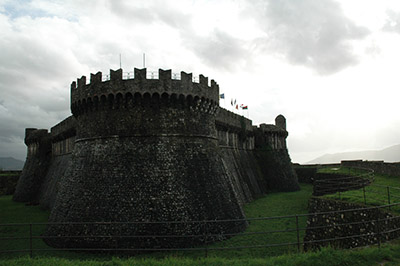 |
Fortezza di Sarzana
Sarzana, Italy
|
|
 |
Constructed: 1487 - 1504
Used by: Genoa, Sardinia, Italy
Conflicts in which it participated:
War of the Austrian Succession
|
The town of Sarzana is located at the entrance of the Magra River valley, at the border of what were the Roman provinces of Etruria and Liguria. Once Rome was no more, approximately twenty six billion city-states of Italy began squabbling for prominence, and Pisa emerged as a mighty maritime nation. Sarzana developed as a communications nexus for Pisa's Bishop and law courts.
Pisa built a fort at Sarzana in 1249, but seeing as it was a pre-starfort, it was an easy matter for the Florentines, under the command of Lorenzo de' Medici (1449-1492) to overcome and destroy it.
|
 |
|
|
The Forentines came to Sarzana in what was sure to be the crowning glory of the Serrezzana War of 1487. As leader of Florence, Medici was known as a patron of the arts, responsible for the funding of works by such artists as Michelangelo (1475-1564) and Leonardo da Vinci (1452-1519). We may also have Medici to thank for the world's first starfort!
|
|
 |
Definitively nailing down the very first starfort may be difficult, but the Fortessa di Sarzana just might be it. Determined to solidify his hold over this strategically important region, Medici had a new fort built atop the ruins of the one he had destroyed at Sarzana.
He brought Florence's leading military architects to the scene, including someone named Luke of the Goats, whom I would like to think was singlehandedly responsible for the first starfort. Luke and his magical starfort-producing goats notwithstanding, the end result was an incremental step towards full-blown starfortery. |
|
Most of the Fortezza di Sarzana looks like a standard castle: Three rounded tower ramparts connected by curtain walls. Starfort devotees will recognize the ravelin in front of the fort's main gate, however. The ravelin would become a familiar sight on many a starfort of the future.
In September of 1494, France's King Charles VIII (1470-1498) marched into northern Italy with 25,000 men. Our Fortezza was not involved in the fighting, but through some convoluted series of events Sarzana came under the influence of another of the major city-states; Genoa.
|
 |
Ladies and gents, may I present what just might be the very first pointy starfort corner: Fortezza di Sarzana's ravelin. |
|
The Genoese completed construction of the Fortezza. Was it they who were responsible for the Ravelin? My money's still on the goat guy.
Genoa spent various periods being dominated by either France or Spain (and/or Austria), and whomever was not currently running Genoese things would be actively trying to do so. France was in charge at the beginning of the 18th century, and built new gun positions on the Fortezza's two leading ramparts.
|
| The Fortezza di Sarzana's western rampart: Weird! Thanks to cepolina.com for the picture! |
 |
When Holy Roman Emperor Charles VI (1685-1740) died in October of 1740, his daughter Maria Theresa (1717-1780) was ready and waiting to take over rule of the Habsburg dominions. Several of those dominions disagreed with her right to rule, however. The War of the Austrian Succession (1740-1748) began with Prussia invading Silesia and eventually spread as far as North America and India.
The war came to Sarzana in 1747, in the form of Austrian troops. Fearing that the Austrians would take refuge from the Fortezza in the town of Sarzana, which at the time was huddled up close to the fort, the Genoan authorities had all 120 buildings of the town torn down.
|
|
The Austrians were unable to defeat the Fortezza di Sarzana, and the town relocated to its present location, a little south of the fort.
The Republic of Genoa finally fell in 1796. The French Revolutions and the subsequent Italian campaigns by Napoleon (1769-1821) brought the French back to Sarzana. Napoleon had family history in the region, as his ancestors had moved to Sarzana in the 13th century (a branch of which would later move to Corsica, which was where Napoleon was born), and he reportedly took great interest in the town. This interest included much grandiose planning of defenses that were never built.
|
When the French were on their way out of northern Italy in 1814, orders were given to destroy the Fortezza di Sarzana. Fortunately this did not come to pass, and the Congress of Vienna (1814) granted Sarzana and its surroundings to the Kingdom of Sardinia. The Sardinians performed a restoration of the fort in 1837, whereupon it was visited by King Carlo Alberto (1798-1849), who doubtless said something like, "Dude, this is one weird lookin' starfort."
As was the fate of many starforts, the Fortezza spent most of its years as a prison.
|
 |
 The less pointy side of the Fortezza di Sarzana The less pointy side of the Fortezza di Sarzana |
|
In the 1920's as the Fascist movement was on the rise in Italy, ten Fascists were imprisoned at the Fortezza. At dawn on July 21, 1921, a group of 300 Fascists attempted to storm the Fortezza to release their comrades, but were met with and turned back by armed resistance from the Sarzana police and townspeople: The Fascist band was scattered into the surrounding countryside, losing fifteen of their number to gunfire. This was one of very few instances of such resistance to Fascist activity in Italy.
Today, the Fortezza di Sarzana is open to visitors year 'round.
|
|
|
|
|
|
 |




